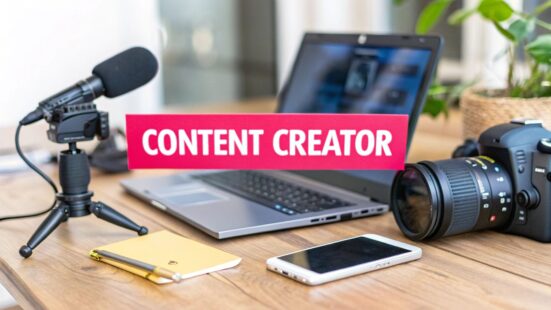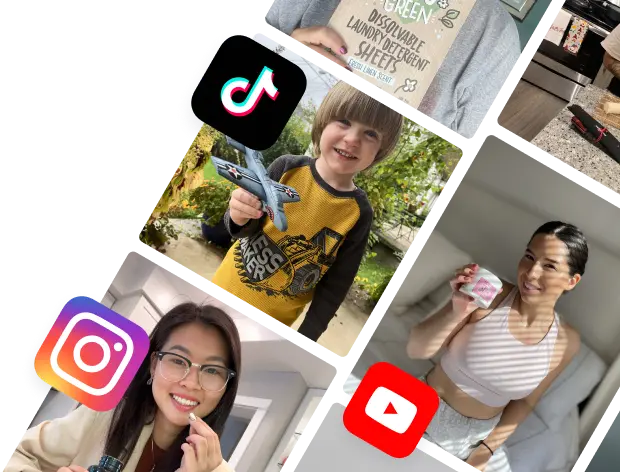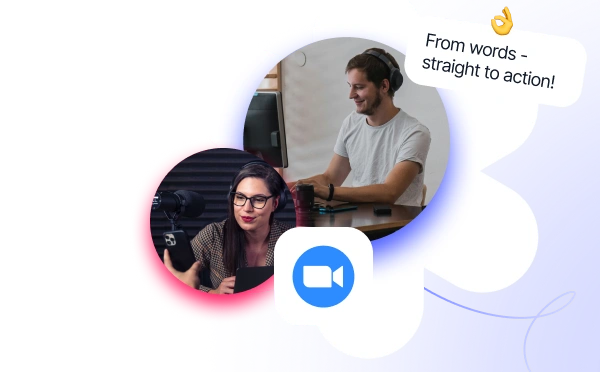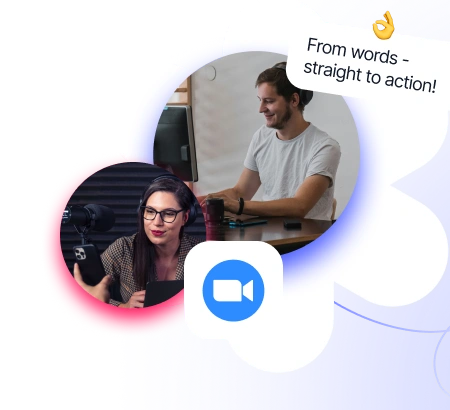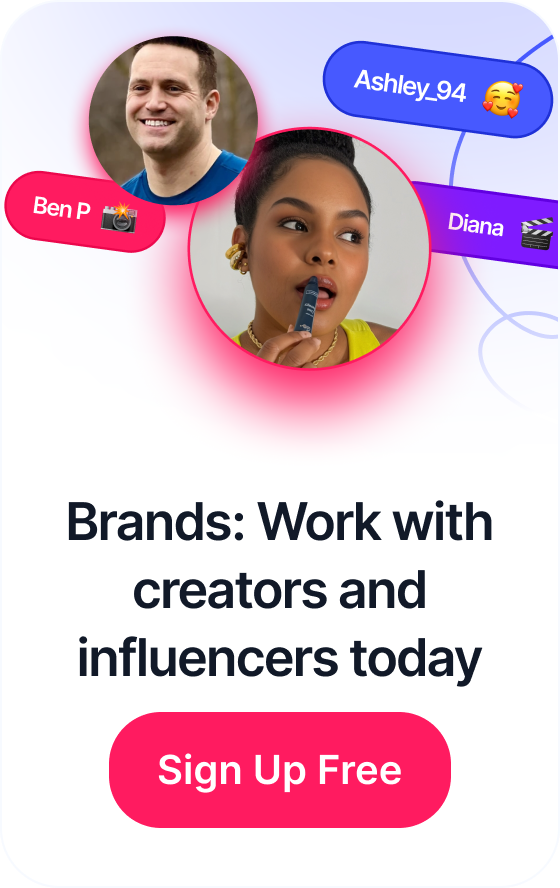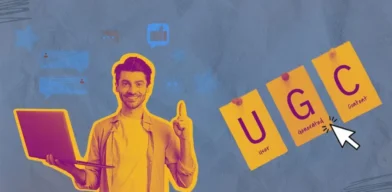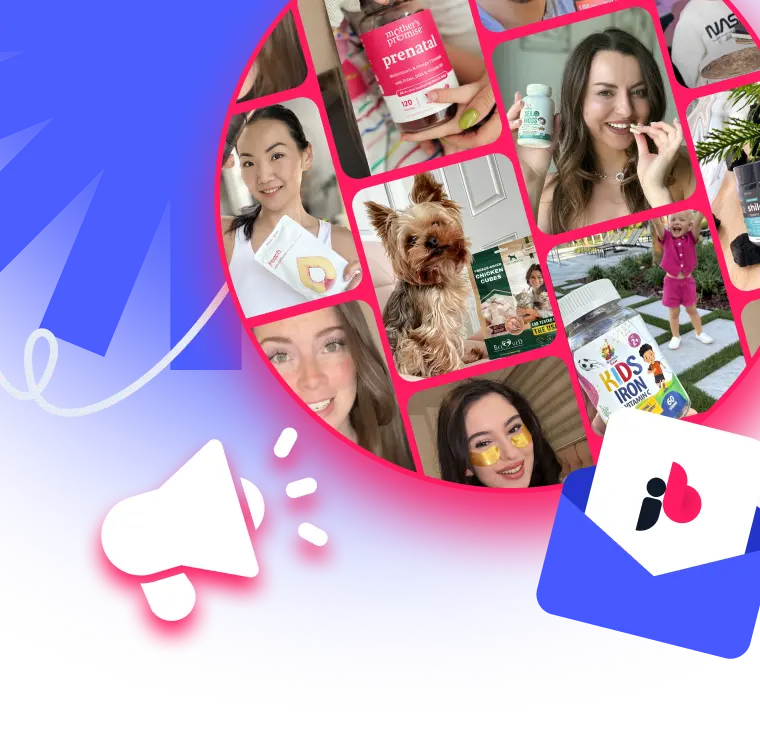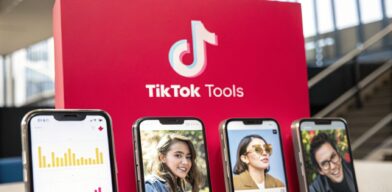 2025 List of TikTok Influencers: Top 7 Tools to Find Them
2025 List of TikTok Influencers: Top 7 Tools to Find Them
At its core, a content creator is someone who makes stuff—videos, articles, photos, podcasts—for people to consume online. They are the modern-day storytellers, teachers, and entertainers of the internet, building communities around their passions by sharing things their audience finds valuable or just plain fun.
Table of Contents
What Is a Modern Content Creator

Forget the old idea of a hobbyist just posting for fun. Today's content creator is really a multifaceted digital entrepreneur. Think of them as the founder, CEO, and entire creative team of their own mini-media company. They're in charge of everything from high-level strategy down to the nitty-gritty production details.
Their job isn't just about hitting "record" or "publish." It's a constant balancing act between creative vision and cold, hard data. At the heart of it all is mastering content creation on social media, where they churn out everything from polished videos to deeply researched blog posts.
This means they have to wear a lot of different hats, often all at once. One minute they're a strategist, mapping out a content calendar and digging into audience analytics. The next, they're a hands-on producer, filming, writing, or designing the content itself. This wide-ranging skill set is what separates the pros from the amateurs and turns a personal passion into a real career. For a deeper look into this role, our guide on the digital creator meaning offers some great additional insights.
A content creator doesn't just make content; they build a business around their voice, turning audience attention into a sustainable enterprise.
To really get a handle on what this all entails, it helps to break down their responsibilities into four key roles. Each one is absolutely critical to their success, transforming them from someone who just posts online into an influential figure in their niche.
The Four Core Hats of a Content Creator
The modern creator's job is a blend of art, science, and business. The table below breaks down the four primary functions they juggle to build and sustain their brand.
| Role | Key Responsibilities |
|---|---|
| Strategist | Plans content calendars, researches trends, analyzes audience data, and sets growth goals. |
| Producer | Writes scripts, shoots and edits videos, designs graphics, records podcasts, and writes articles. |
| Community Manager | Engages with followers, responds to comments, builds relationships, and fosters a loyal community. |
| Analyst | Tracks performance metrics, measures campaign success, and adjusts strategy based on data insights. |
As you can see, it's a dynamic role that demands a unique mix of creativity, technical skill, and business acumen. Mastering these four areas is what allows a creator to not just survive, but thrive.
The Creator Economy Is Reshaping Media
The explosion of individual creators isn't just another social media trend—it's a massive economic shift. What started as a small community of bloggers and YouTubers has snowballed into a global force known as the creator economy. This new ecosystem allows individuals to build their own businesses by connecting directly with an audience, completely sidestepping traditional media giants.
Think back a few decades. If you wanted to make a TV show, you needed a network. To get a book published, you had to land a deal with a major publisher. Today, anyone with a smartphone and a good idea can build their own media empire right from their bedroom, broadcasting to millions without asking for permission.
That direct line to the audience is the creator economy's superpower. Creators aren't just pushing out content; they're building real trust and deep relationships with their followers. This creates the kind of highly engaged communities that old-school media companies can only dream of. It’s a two-way conversation, which is why their content feels so personal and authentic.
A Rapidly Expanding Market
The sheer scale of this movement is mind-boggling. The creator economy is one of the fastest-growing parts of the digital world, with a global market size already hitting an estimated $205.25 billion. Fueled by over 200 million creators around the globe, this number is projected to absolutely skyrocket to $1,345.54 billion by 2033. You can dig into more of these incredible growth stats on uscreen.tv.
But this isn't just about influencers landing a few brand deals here and there. It's a whole system of software, tools, and platforms built to help creators operate like independent business owners, giving them all sorts of ways to make a living.
The creator economy has democratized media by giving individuals the tools to turn their passion and expertise into scalable, independent careers.
New Paths to Monetization
This new economic model has cracked open a ton of different ways for creators to earn an income that go way beyond old-school advertising. Some of the most popular methods include:
- Brand Sponsorships: Teaming up with companies to create dedicated content.
- Affiliate Marketing: Earning a commission by recommending products they actually use and love.
- Selling Digital Products: Making their own courses, e-books, presets, or templates.
- Direct Audience Support: Using platforms like Patreon or channel memberships to get recurring support from their most loyal fans.
Having multiple income streams like this gives creators the financial stability they need to keep focusing on what matters most: making great content for their audience.
Exploring the Different Creator Archetypes
Let's be honest, the term "content creator" is a massive umbrella. It's not a one-size-fits-all label. It covers a huge, diverse group of people, each with their own unique way of doing things.
Think of it like this: an artist can choose to sculpt clay or paint on a canvas. A creator does the same, picking a medium that best fits their voice and what they want to say. This single choice shapes everything—their content, the community they build, and ultimately, their entire career.
Instead of getting hung up on platforms and calling someone a "YouTuber" or a "TikToker," it's way more helpful to think in terms of archetypes. These are like creative personas, defined by the type of content they make and the value they give their audience.
The Major Creative Personas
While you can find a niche for just about anything these days, most creators fit into one of several core archetypes. Each one builds their brand around a specific skill and delivers value in a completely different way.
The Video Storyteller: This creator lives and breathes visual narratives. They could be a gamer streaming live on Twitch, a filmmaker producing slick short docs for YouTube, or a comedian crafting viral skits for Instagram Reels. Moving pictures are their primary tool, and their mission is to entertain, educate, or inspire through a great story.
The Visual Artist: For this creator, it’s all about the aesthetics. We're talking about photographers, graphic designers, and illustrators who use platforms like Instagram and Pinterest as their personal digital galleries. They build a following by creating stunning imagery that nails a specific feeling, idea, or style. They often make money through prints, presets, or slick brand collaborations.
Understanding these archetypes helps clarify that being a content creator is less about the platform you use and more about the kind of value you consistently provide to your audience.
The Experts and Entertainers
It's not all about visuals, though. Other archetypes build their followings on deep knowledge or captivating audio, catering to people who want specific information or something they can listen to on the go.
The Niche Expert: This creator’s entire platform is built on a solid foundation of deep knowledge. They are the financial advisors breaking down complex market trends on a blog, the software developers walking you through coding tutorials, or the historians sharing fascinating tidbits in detailed threads. Their authority and expertise are their biggest assets.
The Audio Producer: This archetype connects with their audience purely through sound. Podcasters are the most obvious example, creating intimate, long-form conversations that people can tune into during their commute or while multitasking. Their success really boils down to crystal-clear audio, engaging discussions, and a consistent schedule.
Each of these archetypes represents a different road to building a community and a career. But what ties them all together? A genuine dedication to creating valuable stuff that's perfectly suited for their chosen medium and the people who follow them.
To make this even clearer, let's break down how these different creator types operate. The table below gives a quick snapshot of their primary platforms, the kind of content they usually make, and how they typically earn a living from their craft.
A Snapshot of Creator Archetypes
| Creator Archetype | Primary Platform(s) | Common Content Formats | Monetization Methods |
|---|---|---|---|
| Video Storyteller | YouTube, TikTok, Twitch | Vlogs, short films, live streams, skits | Ad revenue, sponsorships, merch, fan subscriptions |
| Visual Artist | Instagram, Pinterest, Behance | Photos, illustrations, graphic designs | Prints/presets, commissions, brand collaborations, stock photos |
| Niche Expert | Blogs, YouTube, LinkedIn | How-to guides, tutorials, analysis, courses | Affiliate marketing, online courses, consulting, ebooks |
| Audio Producer | Spotify, Apple Podcasts, YouTube | Interviews, solo shows, narrative series | Sponsorships, ad revenue, listener donations (Patreon) |
As you can see, the path for each archetype is distinct. A Visual Artist on Instagram has a completely different business model than a Niche Expert building a blog. Recognizing these differences is key for brands looking to find the right partner and for aspiring creators trying to find their footing.
The Journey from Passion Project to Profession
The highlight reels on social media often paint a picture of effortless success. But the reality for most creators is a story of grit, strategy, and a whole lot of hard work.
Very few people launch day one as a full-time professional. The path almost always begins as a passion project—a side hustle squeezed into evenings and weekends. This transition from hobby to career is a demanding one. It takes more than just creative talent; it demands a true entrepreneurial mindset.
Creators have to become jacks-of-all-trades, mastering everything from video editing and SEO to community management and financial planning. They spend countless hours building an audience and creating content with no guarantee of an immediate reward, all while trying to keep up with constantly changing platform algorithms. It's this dedication behind the scenes that truly defines what a content creator does.
This infographic breaks down the core media types that form the foundation of a creator's work.
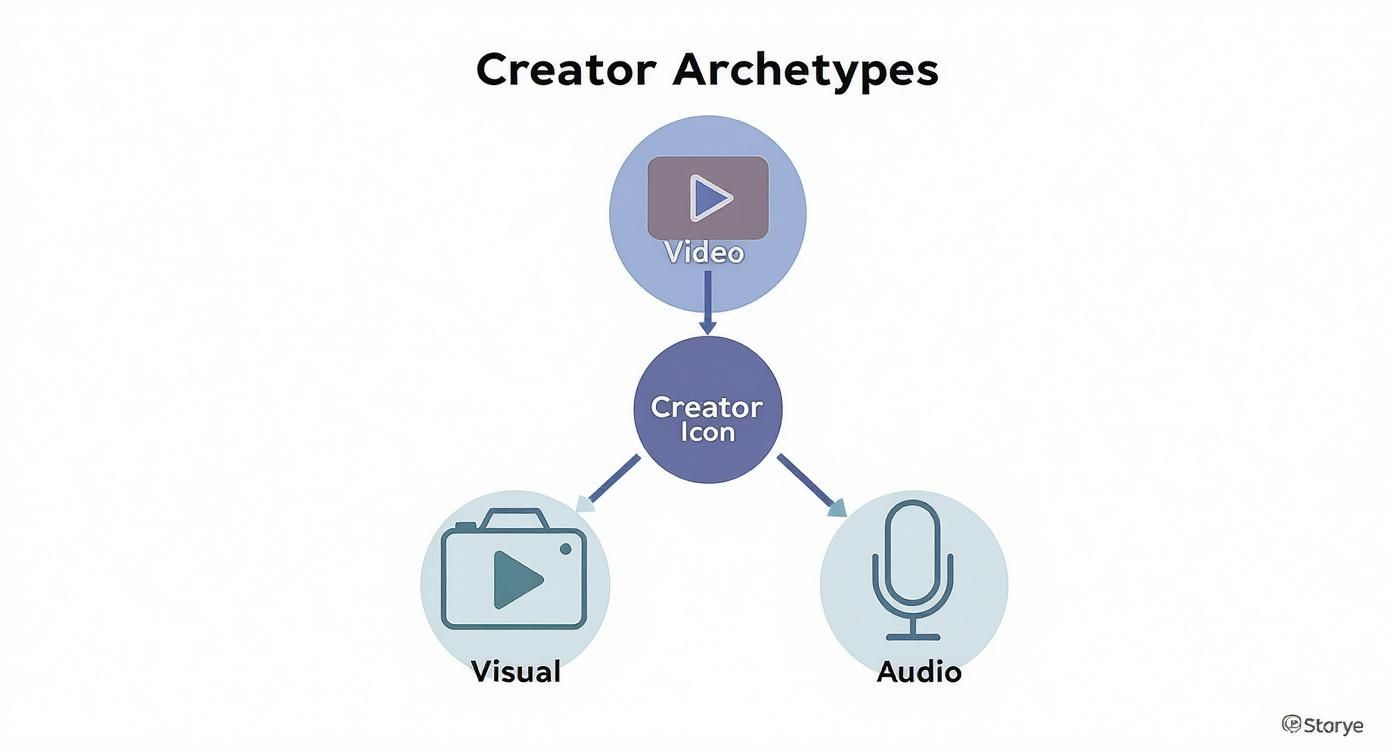
As you can see, creators typically specialize in video, visual, or audio formats to connect with their specific audience in the most effective way.
The Reality of Going Pro
The numbers really show how challenging this journey can be. While there are over 162 million creators in the United States, a staggering 6 in 10 still hold down full-time jobs outside of their content work.
Only 2 in 10 have successfully turned their passion into a full-fledged business. This really highlights the major hurdles creators face to become financially sustainable.
The journey from passion to profession is a marathon, not a sprint. It's built on consistency, strategic skill development, and a deep understanding of how to provide sustained value to an audience.
To make that leap, creators have to get smart about monetizing their following. This means looking beyond simple ad revenue and exploring diverse income streams like brand partnerships, affiliate marketing, or even selling their own products.
For those ready to make this transition, understanding how to scale content creation is a crucial next step. And for those just starting out, this practical guide on how to become a content creator offers a fantastic foundation.
How Creators and Brands Create Marketing Magic

The bond between brands and creators has become one of the most powerful forces in modern marketing. Companies are funneling huge portions of their budgets away from old-school ads for one simple reason: a shoutout from a creator someone trusts feels way more real than a glossy ad campaign.
This partnership is a classic win-win. Brands get a direct line to niche communities that are already deeply engaged, all through a voice they know and love. In return, creators get the resources to keep making the awesome content that built their community in the first place.
And this isn't just a passing fad—it's a massive strategic shift. The global influencer market, which is a huge slice of the creator economy, was recently valued at nearly $10 billion and is on track to blow past $30 billion. Brands are now actively hunting for creators with smaller, but incredibly loyal, followings to spark genuine conversations. You can dig into more of the numbers on this growing market on Statista.
In a world saturated with ads, creators offer a shortcut to trust. Their authentic connection with an audience is a form of currency that brands can't replicate on their own.
Key Partnership Strategies
These brand-creator collaborations come in all shapes and sizes, but the goal is always to match the brand's objective with the creator's unique voice. Three approaches have really proven their worth.
- Strategic Sponsorships: This is the most direct approach. A brand pays a creator to feature a product. When it's done well, it doesn't feel like a commercial—it feels like getting a great recommendation from a friend.
- Influencer Marketing Campaigns: Think bigger. These are broader partnerships, often involving a whole squad of creators promoting a product over a specific period to generate a huge amount of buzz all at once.
- Authentic Affiliate Programs: Here, creators earn a cut from any sales made through their custom links. This model really works because it rewards genuine belief in a product; they only make money if their audience is convinced enough to buy.
Knowing how to collaborate with influencers is no longer a "nice to have" skill for marketing teams—it's essential. These partnerships deliver the kind of targeted reach and built-in credibility that today's shoppers crave, making them a non-negotiable part of any serious growth plan.
Got questions about content creators? Good. It's a role that's often misunderstood. Let's clear up a few of the most common ones that pop up.
What Skills Do You Actually Need to Be a Content Creator?
Think of a successful creator as part artist, part CEO of a mini-media company. You absolutely need the creative chops first—whether that's writing, shooting and editing videos, photography, or graphic design. You have to be good at the making part of the equation.
But the creative side is only half the battle. The business hustle is just as important. This means knowing your way around digital marketing, like SEO and social media strategy. It means being able to look at analytics to figure out what your audience is responding to. And it means managing a community to keep people engaged.
Ultimately, great storytelling is the glue that holds it all together and turns a bunch of skills into a recognizable brand.
What’s the Real Difference Between a Creator and an Influencer?
People use these terms interchangeably all the time, but they're not the same thing. Their core purpose is different.
A content creator is defined by what they make. Their world revolves around producing awesome stuff—be it videos, articles, podcasts, or art. Their primary goal is to create something valuable, entertaining, or educational for their audience.
An influencer, on the other hand, is defined by the effect they have on their audience. Their main asset is their ability to sway opinions and get people to take action, especially when it comes to buying something.
Sure, many influencers are also fantastic content creators, but not every creator is trying to be an influencer.
A creator’s main job is production. An influencer’s main job is persuasion. One builds an audience with their craft; the other uses that audience's trust to partner with brands.
For example, a creator might build a loyal following by making detailed woodworking tutorials for a small, passionate group of people. A fashion influencer, however, is often focused on using their style and recommendations to showcase brands and drive sales.
So, How Do Content Creators Actually Make Money?
The smart ones don't just rely on one paycheck. They build a diverse portfolio of income streams because putting all your eggs in one basket (especially one you don't own, like a single social media platform) is a recipe for disaster.
Here are some of the most common ways they earn a living:
- Ad Revenue: This is the classic model, earning money from ads that run on their YouTube channel or a personal blog.
- Brand Sponsorships: Companies pay them to feature products or services in sponsored posts, videos, or articles.
- Affiliate Marketing: They earn a commission whenever someone in their audience buys a product using their unique tracking link.
- Selling Their Own Products: This is a huge one. Think online courses, custom merchandise, e-books, or digital templates.
- Direct Audience Support: Their community chips in directly through platforms like Patreon, channel memberships, or paid newsletters.
A successful creator’s income isn’t just one thing—it’s a carefully built business that rests on the foundation of a loyal and connected community.
Ready to connect with talented creators who can bring your brand's story to life? JoinBrands makes it easy to find, manage, and collaborate with over 250,000 vetted creators for your next campaign. Start your project today!
